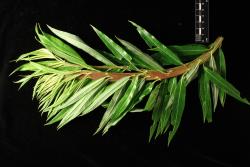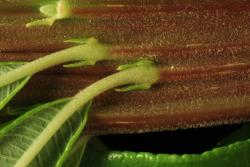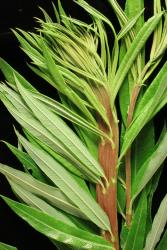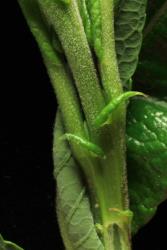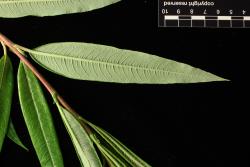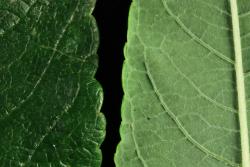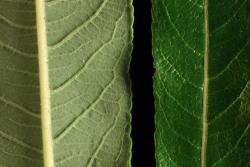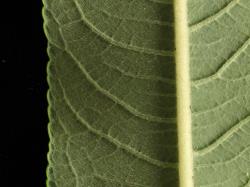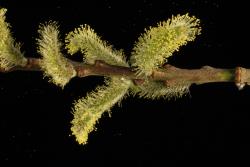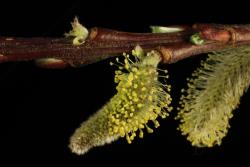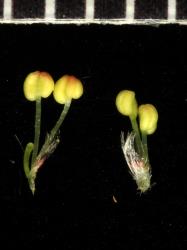- = Salix sachalinensis F.Schmidt, Mém. Acad. Imp. Sci. St.-Pétersbourg, Sér. 7. 12: 173 (1868)
- = Salix opaca Andersson ex Herder, Trudy Imp. S.-Peterburgsk. Bot. Sada 11: 428 (1891)
Tree to 8 m; trunk 0.5 m diameter; bark brown, flaking and fissured, branchlets erect, sometimes peculiarly flattened and then up to 30 mm wide and 3–4 mm deep; wood with sparse short ridges 2 mm long. Current year's branchlets mid-yellow-green (UCL120), tomentose hairs persisting into the second year. Year-old branchlets 2.7–4.7 mm diameter, light yellowish brown to red-brown (UCL76–43). Flower buds 5.5 mm long, 3.0 mm wide, 2.0 mm deep, ovoid, with 2 keels, dark red, covered in moderately dense short-silky hairs. Leaves alternate. Stipule 5–12 mm long, asymmetrically narrowly ovate or narrowly elliptical, not twisted, margins revolute, persisting. Petiole 8–13 mm long, densely velvety, groove absent, glands absent, base not expanded, pale green. Emerging leaves green or slightly tinted orange, strongly revolute, with sparsely villous hairs above, densely velvety below, margins strongly revolute. Proximal leaves toothed. Leaf lamina 98–151 mm long, 26–30 mm wide, length to width ratio 3.3–5.0:1, very narrowly ovate to narrowly elliptical, not falcate; base cuneate to rounded; apex narrowly acute; leaf galls absent; margins densely serrulate or densely crenate, teeth 2 mm apart, finely revolute; upper lamina surface slightly bullate due to impressed veins, midvein raised, medium glossy, glabrous except midvein moderately densely and persistently tomentose, stomata absent; lower lamina surface midvein and side-veins raised, distinctly glaucous, moderately densely short-silky, hairs usually persistent. Male catkins precocious to coetaneous with leaves, catkin flowers opening sequentially. Flowering branch 40 mm long with 0–2 leaves on flowering branch. Male catkin 35–36 mm long, 11–13 mm diameter; catkin rachis visible between flowers. Flower bracts 1.2–1.8 mm long, 0.5 mm wide, bicoloured, crimson turning brown or black, hyaline in lower half, flat; apex acute, sparse to moderately dense long-silky hairs all over. Male nectary 1, 0.5–0.9 mm long, 0.16 mm wide, green or yellow-green. Stamens 2, filaments free, filament hairs absent; anthers 0.8–0.9 mm long, slightly red-tinted.
Branchlets may be fasciated (i.e. fused together to form a single branchlet that is flattened with ridges) and up to 30 mm wide, a feature of 'Sekka'. Leaves are narrowly elliptical to narrowly ovate, the upper leaf surface glabrous with impressed netted veins, the lower leaf surface glaucous with raised veins, with moderately dense, short, straight hairs that are neither appressed nor silky. Emerging leaves are strongly revolute at the margins, but mature leaves are plane at the margins and crenate rather than serrate. Current-year branchlets are velvety, the hairs persisting on 1-year-old branches. Catkins are densely hairy, and the flower bracts are bicoloured (crimson turning black in the distal half). The wood has very short ridges. Plants are capable of becoming a tree with a single trunk 80 cm diameter with flaking, rather than fissured, bark.
Most similar to Salix schwerinii, which also has emerging leaves with strongly revolute margins, and mature leaves of the same size and shape. The leaves of S. schwerinii are also finely bullate on the upper surface, but the lower surface has dense long-silky hairs rather than moderately dense short hairs. Salix viminalis has leaves of similar shape and size, but the lower leaf surface of S. viminalis has denser hairs than S. udensis. The male catkins of S. udensis are longer (35–36 mm) than those of S. viminalis (23–24 mm long). The stipules persist in S. udensis but not in S. viminalis.
In cultivation at Taranaki (Lake Rotokawau 2006), Southern North Island (Palmerston North 2018), Canterbury (Woodend 1994, Waimakariri River 1966, Waimate 1981, Christchurch Botanic Gardens 2021).
Grown at Palmerston North and Christchurch Botanic Gardens.
First collection: CHR 134570, W.R. Sykes, 23 January 1963, Christchurch Botanic Gardens. In 1966 it was collected in the bed of the Waimakariri River behind the North Canterbury Catchment Board office (CHR 232382).
First publication: This publication.
Flowering: Early September–late October.
Diploid, 2n = 38 (CCDB, based on six counts), provisionally confirmed by flow cytometry using PN283.



